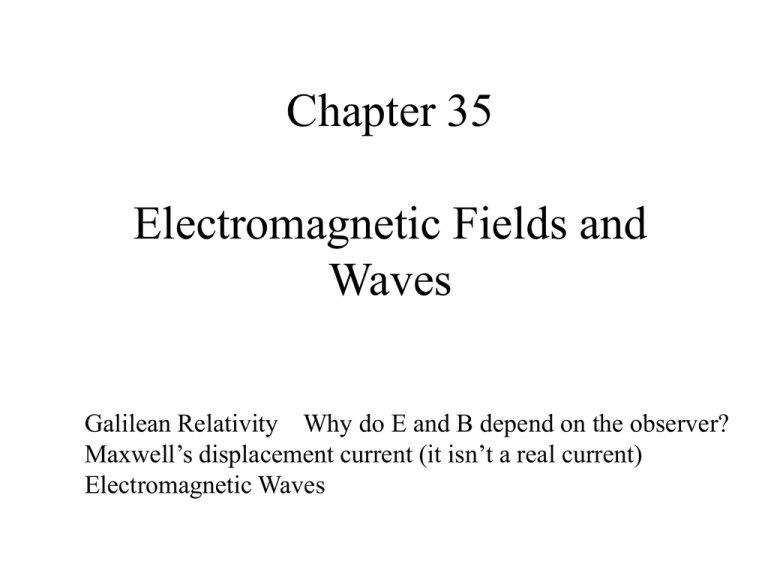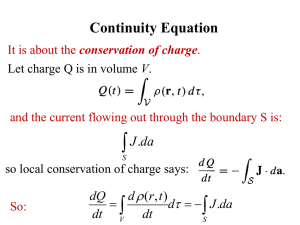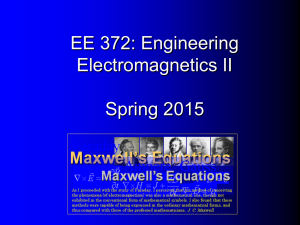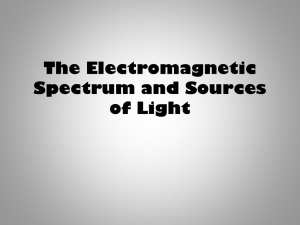Chapt35_VGo
advertisement

Chapter 35 Electromagnetic Fields and Waves Galilean Relativity Why do E and B depend on the observer? Maxwell’s displacement current (it isn’t a real current) Electromagnetic Waves Chapter 35. Electromagnetic Fields and Waves Topics: • • • • • • • E or B? It Depends on Your Perspective The Field Laws Thus Far The Displacement Current Maxwell’s Equations Electromagnetic Waves Properties of Electromagnetic Waves Polarization Preview of what is coming New! Gives rise to Electromagnetic waves. Moving observers do not agree on the values of the Electric and magnetic fields. Observer S says: r r r r F = q E + v¥ B Observer S’ says: r r F = qE How can both be right? ( ) q makes E and B v=0 for him, q makes E Option A: There is a preferred reference frame (for example S). The laws only apply in the preferred frame. But, which frame? Option B: No frame is preferred. The Laws apply in all frames. The electric and magnetic fields have different values for different observers. Qu ickTime™ and a TIFF (Uncompressed) dec ompressor are nee ded to see this picture. Extended Option B: No frame is preferred. The Laws apply in all frames. All observers agree that light travels with speed c. Einstein’s postulates Special Relativity Which diagram shows the fields in frame S´? Qu ickTime™ and a TIFF (Uncompressed) dec ompressor are nee ded to see this picture. What we know about fields - so far Integrals over closed surfaces Gauss’ Law: r Qin — E dA 0 Gauss’ Law: r — B dA 0 Integrals around closed loops Faraday’s Law: r r d E d S m through — loop dt Ampere’s Law: r r — B(r) ds =0 Ithrough Integrals around closed loops Faraday’s Law: r r d E d S m through — loop dt Ampere’s Law: r r — B(r) ds =0 Ithrough Faraday’s Law for Stationary Loops r r EMF — loop E dS r r B dA t Area related by right hand rule r dA r dS Which area should I pick to evaluate the flux? A. The minimal area as shown B. It doesn’t matter Faraday’s Law, no problem r r d — loop E dS dt m through QuickTime™ and a decompressor are needed to see this picture. mthrough Surface r Because for a closed surface — B dA 0 mthrough Surface A r r B dA = Surface B r r B dA r r B dA QuickTime™ and a decompressor are needed to see this picture. r r B( r) d s =0 I through — As long as net current leaving surface is zero, again no problem QuickTime™ and a decompressor are needed to see this picture. Current through surface B is zero QuickTime™ and a decompressor are needed to see this picture. James Clerk Maxwell (1831–1879) en.wikipedia.org/ wiki/James_Clerk_M axwell Thus, for any closed surface r r 0 — E dA Qin d r r I through 0 — E dA Qin dt Maxwell said to add this term r r F e = ÚE³dA S The new term is called the displacement current. It is an unfortunate name, because it is not a current. Maxwell is known for all of the following except: A. Proposing the displacement current and unifying electromagnetism and light. B. Developing the statistical theory of gases. C. Having a silver hammer with which he would bludgeon people. D. Studying color perception and proposing the basis for color photography. r r —B³dS =Bq (r)2pr Ú r r F e = ÚE ³dA = pr 2 Ez S r r dF e B³d S = m (I + e ) 0 through 0 — Ú dt Bq (r) = Recall from Faraday: Eq (r) = - r ŽBz 2 Žt m0 e0 r ŽEz 2 Žt Faraday: time varying B makes an E r r d r r — loop E dS dt S B dA example Eq (r) = - r ŽBz 2 Žt Ampere-Maxwell: time varying E makes a B r r d B ³ d S = m e 0 0 — Ú dt r r ÚE ³ dA S example m e r ŽEz Bq (r) = 0 0 2 Žt Put together, fields can sustain themselves - Electromagnetic Waves r r d B ³ d S = m e 0 0 — Ú dt r r ÚE ³ dA S Based on the arrows, the electric field coming out of the page is A. increasing B. decreasing C. not changing D. undetermined Properties of electromagnetic waves: Waves propagate through vacuum (no medium is required like sound waves) All frequencies have the same propagation speed, c. Electric and magnetic fields are oriented transverse to the direction of propagation. (transverse waves) Waves carry both energy and momentum. mynasadata.larc.nasa.gov/ ElectroMag.html 35.5 - Electromagnetic Waves 1. Assume that no currents or charges exist nearby, Q=0 I=0 2. Try a solution where: r r E(r,t) = Ey (x,t)j r r B(r, t) = Bz (x, t)k Only y-component, depends only on x,t Only z-component, depends only on x,t 3. Show that this satisfies Maxwell Equations provided the following is true: ŽBz (x, t) ŽEy (x, t) Faraday = Žt Žx ŽEy (x, t) ŽBz (x, t) = m0e0 Ampere-Maxwell Žx Žt 4. Show that the solution of these are waves with speed c. Maxwell’s Equations in Vacuum Qin =0, Ithrough = 0 Integrals over closed surfaces Gauss’ Law: r — E dA 0 Gauss’ Law: r — B dA 0 Integrals around closed loops Faraday’s Law: Ampere’s Law: r r d E d S m through — loop dt d r r — B(r) ds =0 0 dt ethrough Do our proposed solutions satisfy the two Gauss’ Law Maxwell Equations? r r r E(r,t) = Ey (x,t)j r B(r, t) = Bz (x, t)k r — E dA 0 Ans: Yes, net flux entering any volume is zero r — B dA 0 What about the two loop integral equations? Faraday’s Law r r r r d — loop E dS dt Surface B dA Apply Faraday’s law to loop r r Ey (x) — loop E dS h Ey (x x) Ey (x) ; hx x Surface r B dA hxBz (x,t) ŽEy (x, t) Žx ŽBz (x, t) =Žt Ampere-Maxwell Law: r r d r r — B(r) ds =00 dt Surface E dA Apply Ampere-Maxwell law to loop: Bz (x) r r — B(r) ds = h Bz (x x) Bz (x) ; hx x Surface r E dA ; hxEy (x,t) ŽEy (x, t) ŽBz (x, t) = m0e0 Žx Žt Combine to get the Wave Equation: ŽEy (x, t) ŽBz (x, t) = m0e0 #1 Žx Žt #2 ŽEy (x, t) Žx ŽBz (x, t) =Žt Differentiate #1 w.r.t. time 2 Ž Ey (x,t) ŽB (x,t) Ž z = m0e0 Žx Žt Žt 2 Use #2 to eliminate Bz Ž2 Ey (x,t) Žx 2 = m0e0 Ž2 Ey (x,t) Žt 2 The Wave Equation Solution of the Wave equation Ž2 Ey (x,t) Žx 2 = m0e0 Ž2 Ey (x,t) Žt 2 Ey (x, t) = f+ (x - vemt) + f- (x + vemt) Where f+,- are any two functions you like, and v = 1/ m e em 0 0 vem is a property of space. vem = 2.9979¥ 108 m / s f+ ,- Represent forward and backward propagating wave (pulses). They depend on how the waves were launched Shape of pulse determined by source of wave. Ey (x, t) = f+ (x - vem t) Speed of pulse determined by medium vem = 1 / m0e0 What is the magnetic field of the wave? Ey (x, t) = f+ (x - vemt) + f- (x + vemt) Magnetic field can be found from either equation #1 or #2 #2 ŽEy (x, t) Žx ŽBz (x, t) =Žt This gives: Bz (x,t) = 1 ( f+ (x - vemt)- f- (x + vemt)) vem Notice minus sign E and B fields in waves and Right Hand Rule: f+ solution f- solution Wave propagates in E x B direction Do the pictures below depict possible electromagnetic waves? A. Yes B. No A. Yes B. No Special Case Sinusoidal Waves Ey (x, t) = f+ (x - vem t) = E0 cos[k(x - vem t)] Ey (x, t) E0 Wavenumber and wavelength k = 2p / l l = 2p / k - E0 These two contain the same information Special Case Sinusoidal Waves Ey (x, t) = f+ (x - vem t) = E0 cos[k(x - vem t)] Ey (x, t) 2p = kvemT E0 Introduce w = 2p / T f = 1/T - E0 Different ways of saying the same thing: w / k = vem fl = vem Energy Density and Intensity of EM Waves Energy density associated with electric and magnetic fields uE For a wave: r 2 0 E 2 uB r 2 B 2 0 r 1 r B E 0 0 E vem Thus: uE u B Units: J/m3 Energy density in electric and magnetic fields are equal for a wave in vacuum. Wave Intensity - Power/area Energy density inside cube r 2 r 2 0 E B uE uB 2 2 0 vem In time t=L/vem an amount of energy r 2 U V(uE uB ) AL 0 E comes through the area A. Volume V=AL Area - A Length - L I=Power/Area U I tA 0 r 2 E 0 Poynting Vector The power per unit area flowing in a given direction 1 r r S EB 0 0 r 2 S I E 0 What are the units of I- W/m2, E - V/m 0 0 Ans: Ohms 0 377 0 Antennas Simple dipole AM radio transmitter Power radiated in all horizontal directions Earth is a good conductor Image charges The amplitude of the oscillating electric field at your cell phone is 4.0 µV/m when you are 10 km east of the broadcast antenna. What is the electric field amplitude when you are 20 km east of the antenna? A. 4.0 µV/m B. 2.0 µV/m C. 1.0 µV/m D. There’s not enough information to tell. Polarizations We picked this combination of fields: Ey - Bz Could have picked this combination of fields: Ez - By These are called plane polarized. Fields lie in plane Integral versus Differential Versions of Maxwell’s Equations Integral Differential r Qin — E dA r E r — B dA 0 r B 0 0 r r r r d — loop E dS dt Surface B dA r r d r r — B(r) ds =0 (Ithrough 0 dt surface E dA) Charge density 0 r r B E t r r r E B 0 ( J 0 ) t Current density






